Hi,
reading Günter Nagel`s "Himmlerswaffenforscher" (Helios Verlag, Aachen, 2011) there are quite a handfull of rocket projects in development by Pibrans stated in page 219.
Pibrans was a firm integrated in "Waffen Union" with Skoda and other companies, more or less under the aegis of the SS.
On the familiar side there were: V-101, Rochen, Püppchen, Panzerfaust, Panzerschrek, Taifun P/F, Luftfaust and Panzerblitz.
These are the mentioned programs which are unknown to me:
Zugspitze;
"PAR" (probably stands for Panzerabwehrrakete) rocket series (two are noted, II and V);
Regenschirm project, in experimental stage;
"7-Kreiser"
Is there someone who can shed light on this subjects? Maybe our "resident rocket scientist", Grzesio?
reading Günter Nagel`s "Himmlerswaffenforscher" (Helios Verlag, Aachen, 2011) there are quite a handfull of rocket projects in development by Pibrans stated in page 219.
Pibrans was a firm integrated in "Waffen Union" with Skoda and other companies, more or less under the aegis of the SS.
On the familiar side there were: V-101, Rochen, Püppchen, Panzerfaust, Panzerschrek, Taifun P/F, Luftfaust and Panzerblitz.
These are the mentioned programs which are unknown to me:
Zugspitze;
"PAR" (probably stands for Panzerabwehrrakete) rocket series (two are noted, II and V);
Regenschirm project, in experimental stage;
"7-Kreiser"
Is there someone who can shed light on this subjects? Maybe our "resident rocket scientist", Grzesio?


